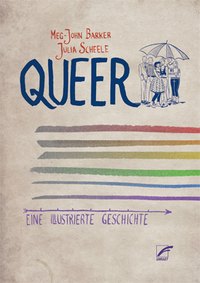Take a photo of a barcode or cover
1.06k reviews for:
Queer: Eine illustrierte Geschichte
Jennifer Sophia Theodor, Meg-John Barker, Julia Scheele
1.06k reviews for:
Queer: Eine illustrierte Geschichte
Jennifer Sophia Theodor, Meg-John Barker, Julia Scheele
This is a very academic text and I’m not in the headspace to read it right now.
informative
slow-paced
I gave this a low rating largely because I came into it with the expectation that it would be a literal queer history...which this was not. It was a skim of queer philosophy and theory. I also rated this low because it bothered me that some of the graphic portrayals were copied within the story, rather than drawn differently. I can't imagine how much time it took to put those drawings together but it felt like a letdown to see repeated faces.
For me, the part that resonated was the last few pages called, "Thinking (completely) Queerly." This section gave questions someone could ask themselves when they are examining the world around them. I liked, "Instead ask what an idea or representation opens up and closes down. What is included and excluded? Might it be a matter of both/and rather than either/or?" That's actually something I can use in daily life that I really appreciated.
All that is to say, I would only recommend this to someone else if they want a really zoomed-out view of queer theory and philosophy.
For me, the part that resonated was the last few pages called, "Thinking (completely) Queerly." This section gave questions someone could ask themselves when they are examining the world around them. I liked, "Instead ask what an idea or representation opens up and closes down. What is included and excluded? Might it be a matter of both/and rather than either/or?" That's actually something I can use in daily life that I really appreciated.
All that is to say, I would only recommend this to someone else if they want a really zoomed-out view of queer theory and philosophy.
challenging
funny
hopeful
informative
inspiring
lighthearted
reflective
medium-paced
informative
inspiring
very comprehensive look at most of queer theory
A really interesting introduction to queer theory. I know the creators work really hard to make it accessible. Still, even as someone who studied some of the theorists mentioned (way back when in college) it was a dense start. I did hit my stride though. Even without going into too much depth this is a book that I think requires multiple readings. I did really like how the graphics help illustrate the points - and used population culture references.
a graphic history about queer theory manages to make high academic thought accessible to anyone. having no background in any queer theory this book managed to be a nice introduction to the topics as a whole. it really made me want to take a class or two about queer theory!
informative
slow-paced
Highly informative, if a bit dense at times. Only provides a taste of most of the theory it touches on, but still a good introduction to the subject matter. The visual style was also interesting.
So I appreciate what this book was trying to do, even if it has a number of issues. Distilling queer theory is no easy task, and frankly, not sure if it’s even something worth doing. While the first half or so of the book is very good at explaining concepts in ways that are easy to understand, everything goes downhill once queer theory is mentioned. The fact that the vast majority of people quoted and discussed in this book are white is deeply troubling, and even ACKNOWLEDGED halfway through the book…so it was majorly frustrating that even possessing a self-awareness of the book’s whiteness, the authors still did the bare minimum to incorporate diversity. Pages on pages about Judith Butler (and Camille Paglia as the representative feminist?!?) but we get just a few sentences on disability and fat activism? Not even a full page! All in all, a great jumping-off point for those looking to broaden their understanding of queer ideology, but far from comprehensive or inclusive.
informative
fast-paced
The most difficult graphic novel I've ever read. This book would benefit from some concept separation via chapters. I could see small links between each page, but it was so difficult to read when every page was packed with so much information and very little elaboration to make it stick. This resulted in me rereading a lot of pages as still retaining very little. I thought the concepts being presented are pretty interesting to consider, and they made for great conversation for Queer book club. I think this book creates a lot of different paths for people studying queer theory to choose to pursue and investigate further, but it doesn't make a great resource to refer to when trying to get more in depth into the multitude of concepts it covers.
Dense but informative. As someone who has never studied queer theory but has picked up the jist of several debates and viewpoints online, it was interesting to see the definitions and originators of these ideas.
No one asked but my main hang-ups on engaging with the theory would be on what the author introduces as materiality (p 147 - 149).
No one asked but my main hang-ups on engaging with the theory would be on what the author introduces as materiality (p 147 - 149).







